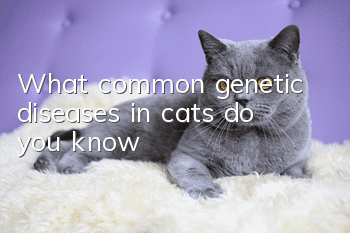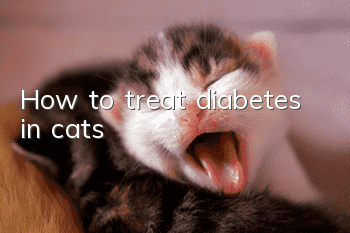What common genetic diseases in cats do you know?

The round head, drooping ears and suffocating innocence of the folded-eared cat make people fall in love with it at first sight and make them unable to move. Immediately after, catteries and people who raise Fold-eared cats at home continue to receive various messages about buying Fold-eared cats. The greater our desire and demand for Fold-eared cats, the more unscrupulous breeders are increasing.
As for the genetic disease of folded-eared cats, it is difficult to cure even if a lot of manpower and material resources are spent. We can only rely on long-term drug support to alleviate the pain. But this often requires a large amount of capital investment. Even if most people are willing at the beginning, it will be difficult to maintain it in the end and have to give up; some people even abandon it directly and let it fend for itself.
Fold-eared cats are not the only cats with genetic diseases.
Purebred cats with obvious genetic history:
Rex Cat (9-15 years old)
Curly and wavy hair, narrow neck, big ears
Genetic diseases: congenital myasthenic syndrome, polycystic kidney disease, Myanmar hypokalemia
Abyssinian cat (9-15 years old)
The hair color is darker, the head is triangular, and the big ears are forward
Genetic diseases: progressive retinal atrophy, pyruvate kinase deficiency
Manx Cat (8-14 years old)
Short hair, no tail
Genetic diseases: spinal defects (spina bifida, etc.)
Norwegian Forest Cat (14-16 years old)
Tufted ears, fluffy tail, long hair
Genetic diseases: glycogen storage disease type IV, pyruvate kinase deficiency, hip dysplasia
Bengal cat (12-16 years old)
Spotted/marbled pattern, triangular head, thick neck, broad feet
Genetic diseases: progressive retinal atrophy, pyruvate kinase deficiency, knee dislocation, hip dysplasia
Burmese cat (16-18 years old)
Compact and clumsy body, round limbs, ears, chin, paws, short hair
Genetic diseases: head defects, hypokalemia, glaucoma, kidney stones
Ragdoll cat (12—17 years old)
Blue eyes, long hair
Genetic diseases: bladder stones, hypertrophic cardiomyopathy, polycystic kidney disease
Siamese cat (15-20 years old)
Short hair, blue eyes, triangular head, high ears, black face
Genetic diseases: gangliosides, polysaccharidosis, progressive retinal atrophy
Himalayan cat (over 15 years old)
The face is flat and hairy
Genetic diseases: progressive retinal atrophy, polycystic kidney disease, respiratory diseases
Maine Coon Cat (12-15 years old)
Thick hair, big head, high ears, long body, up to 1 meter long
Genetic diseases: hypertrophic cardiomyopathy, hip/elbow dysplasia, spinal muscular atrophy, hypertrophic cardiomyopathy
Persian cat (over 15 years old)
Flat face, short hair
Genetic diseases: progressive retinal atrophy, polycystic kidney disease, hypertrophic cardiomyopathy, bladder stones, respiratory diseases
Common genetic diseases in cats:
Can genetic diseases be cured?
Genetic diseases are caused by some congenital reasons such as inbreeding. Gene differences can cause different genetic defects, mutations and other problems. Generally, purebred cats have a high probability of getting genetic diseases. Different genetic diseases will also occur in the same breed, and they will not show up in the kitten period. The high incidence period is generally between 1 and 3 years old.
Treatment methods for genetic diseases are limited. Currently, drugs, surgery, and radioactive treatment can only be used to alleviate the pain caused by the disease and prolong life. Fortunately, not every cat will develop the disease, but all cats are at risk. The severity of symptoms and age of onset vary from individual to individual.
Hereditary diseases resulting in physical defects due to breeding:
· Folded-eared cats: osteochondrodysplasia/dysplasia, hypertrophic cardiomyopathy
· Hairless cats: Burmese hypokalemia, congenital myasthenic syndrome, polycystic kidney disease, progressive retinal atrophy
· shortLeg cats: osteochondrodysplasia/dysplasia, hypertrophic cardiomyopathy
· Short-haired cats: progressive retinal atrophy, polycystic kidney disease, immune lymphoproliferative syndrome
I cannot make all breeders stop breeding cats with genetic diseases, but I can tell everyone in advance the impact of genetic diseases on cats.
I can't make everyone refuse to buy, but I can remind everyone that they must take responsibility for their life before buying.
Even if the incidence of genetic diseases in cats is not 100%, we should not take a lucky attitude.
- What to do if a male cat in heat urinates everywhere
- What causes yellow urine in cats
- Can I deworm my cat again if there are still fleas after deworming?
- The cat keeps meowing when no one is with him
- What should I do if my newborn kitten has fleas?
- How to tell how old a Korat cat is
- Are Turkish Angora cats easy to raise?
- What will happen if the cat is not dried after bathing?
- Will a depressed cat have a fever?
- Can a female Fold-eared cat give birth to kittens?



